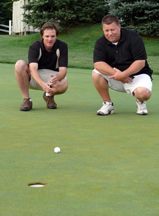Purdue 'tool box' could be ace in the hole for golf courses

Purdue Extension turfgrass specialist Cale Bigelow, from left, and graduate research assistant Tracy Tudor test ball roll performance on a putting green at Purdue's William H. Daniel Turfgrass Center. Their research has found that golf course managers can maintain attractive, playable greens with less work and at a lower cost. (Purdue Agricultural Communication photo/Steve Leer)
WEST LAFAYETTE, Ind. - Below par looks great on the leaderboard but never when it describes the appearance and playability of golf course putting greens. Purdue University researchers are working to help course managers produce winning greens at lower cost and with less labor.
That's important at a time when many courses are struggling economically, said turfgrass specialist Cale Bigelow.
"Managers are trying to strike a balance between the aesthetics of the putting green and turf health," Bigelow said. "They also have to think about player use. It can be extremely expensive to provide the right consistency across a golf course."
Bigelow and Tracy Tudor, a graduate research assistant, are developing a course manager's "tool box" of recommended practices for establishing and maintaining putting greens. Two years into their research, they already have identified practices that could improve greens while allowing golf courses to realize cost savings of 5 percent to 10 percent a year.
Those practices include more timely and selective use of fertilizers and products that slow grass growth, help the turf retain moisture, and minimize the encroachment of annual bluegrass - an enemy of standard creeping bentgrass greens.
"We're looking at combinations of practices in our tool box because we know many golf courses are on limited budgets," Tudor said.
Of all golf course grass, putting greens require the most attention. In Indiana alone about one-fourth of a course's annual average operating budget of $600,000 to $700,000 goes toward upkeep of greens, Bigelow said.
Course managers are hesitant to scrimp on greens because players expect putting surfaces that are attractive and allow for proper ball roll. Yet many courses must trim expenses in the face of declining revenues.
A study by the National Golf Foundation shows just how tough the economy has been on the golf industry. The report found that the number of golfers in the United States fell from slightly more than 30 million in 2003 to 27.1 million in 2010.
Consequently, more courses are closing than opening nationwide. The NGF reported a net loss of 61 courses in 2010, the fifth consecutive year closings outpaced openings. The organization projects a return to growth for the industry in the years ahead, however, as more women and minorities take up the game.
"It's not easy out there for a lot of managers, and they're looking for any little place where they can save a few dollars," Bigelow said.
In their research, Bigelow and Tudor have examined all facets of greens preparation, from seeding to watering to weed control to mowing. During tests conducted at Purdue's William H. Daniel Turfgrass Center, the researchers have focused on management strategies for reducing the time and resources necessary to produce sustainable greens.
Early results are encouraging. Bigelow and Tudor have found that using plant growth regulators and soil surfactants in concert both slows grass growth and helps the soil beneath retain adequate moisture levels, providing a firmer putting surface that could be mowed less often.
"These are usually liquid applications that can be mixed together in a sprayer and then applied," Tudor said. "As managers work with them they can evaluate performance and find the application rate that's best for them. Using these products provides a cost savings as far as time and labor are concerned."
Research indicates there's another benefit derived from treating greens with growth regulators and soil surfactants.
"There is some evidence that you can reduce your fungicide requirements," Bigelow said. "In the climate that we live in, where disease on putting greens is relatively common during summer months, each fungicide spray can be fairly expensive."
Another area of potential cost savings is fertilization. The researchers have noticed that applying nitrogen at lower rates to putting greens often produces grass as healthy as greens fertilized with higher volumes of nitrogen.
In separate but related research, Bigelow is testing non-traditional grass cultivars that could be grown as lower-cost alternatives to creeping bentgrass.
The Purdue putting green study will be completed later this summer, and Bigelow and Tudor expect to release "tool box" recommendations in time for the 2012 golf season.
Additional turfgrass information is available at the Purdue turf science website, at https://www.agry.purdue.edu/turf/
Writer: Steve Leer, 765-494-8415, sleer@purdue.edu
Sources: Cale Bigelow, 765-494-4692, cbigelo1@purdue.edu
Tracy Tudor, 765-413-2907, wtudor@purdue.edu
Ag Communications: (765) 494-2722;
Keith Robinson, robins89@purdue.edu
Agriculture News Page
Related website:
Purdue Agriculture
